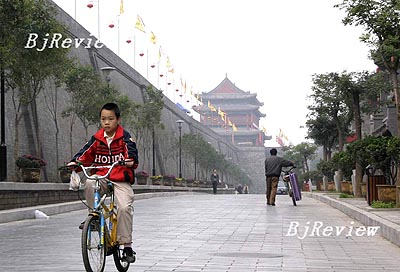|

打造创新型城市
73岁的退休教授肖良勇,在西安是一位富有传奇色彩的创业"英雄"。这位在65岁退休之后开始创业的老人,凭借自己的科研实力和商业眼光,在短短8年时间里,不仅将一家背负上千万元债务的小企业,变成了一家在香港上市、总资产达到4.7亿元的国际知名企业,而且他研制的民族天线产品--海天天线(Haitian Antenna),打破了跨国公司垄断中国基站天线市场的局面,促使国外同类产品价格整体下降60-90%,为国家节省外汇约9亿美元。
肖良勇是西北电子科技大学的一名教授,长年从事新型军事天线的研制工作,并取得了比较丰硕的科研成果。"在学校我只能申请课题研究,最多的经费只有20多万元,而且研究的产品只限于军事方面,完全与市场脱节。" 肖良勇直言。
1999年临近退休前夕,肖良勇有一次翻阅资料时,无意中了解到美国麻省理工学院华裔教授朱兰成在30年代就创办了CHU天线公司,经过40多年的发展,CHU已成为世界知名的大企业,美国海军的天线大部分由其提供。
这件事对肖良勇触动很大,他很快也萌生了创业的念头,想把自己的研究成果转化为产品,于是他将目光转向了民用天线产品。因为他了解到,时值中国大力发展移动电话小灵通(PHS)业务,可由于市场垄断,国内小灵通(PHS)基站当时使用的都是价格高昂的进口天线。
1999年10月,正式退休的肖良勇收购了一家负债累累的通讯设备公司,并很快研制出自己的产品--海天天线。由于产品性能好,价格又便宜,短短3个月之内,海天天线就夺取了90%以上的国内PHS基站天线市场。与此同时,朗讯、UT斯达康、摩托罗拉、华为等一大批显赫的海内外知名企业,也成了海天天线的大用户。
"我不喝牛奶,不吃面包,别看我年龄这么大,我每天至少要工作十四五小时。" 肖良勇笑着说。虽然已经退居二线,可这位精神矍铄、谈吐幽默的老人仍有一个雄心勃勃的目标:"哪里有无线,哪里就有天线;哪里有天线,哪里就有海天。"
不过,回忆起当年创业的情景,肖良勇还是感慨良多。"创业时,企业名气不大,研发需要资金,找银行贷款,银行不理。在这种情况下,西安高新区代表国家支持了数千万元,仅帮助海天申请国家专项基金支持就是2900万元。这对我们企业后来的发展是至关重要的。" 肖良勇说。
西安高新区是1991年3月经中国国务院首批设立的国家级高新技术开发区。由于具备优越的市场化的创新环境,如今一大批像海天天线这样的科技型企业迅速在海内外崛起。据西安高新区管委会主任景俊海介绍,西安高新区平均每天成立4家科技企业,平均每天转化3项科技成果,平均每家高新技术企业拥有2项以上专利,70%的核心专利已经实现产业化。迄今为止,世界上第一台SP30超级程控交换机、数字化虚拟演播室、世界三大无线通讯标准等一批具有自主知识产权、国际一流水平的重大产业化项目都诞生在西安高新区。
中国准备重点建设5个世界一流高新区,西安高新区属于其中之一。"我们现在面临的考验是,能否具备全新的视野,以世界眼光来把握科技产业的发展。" 景俊海坦言。
"到2015年,西安要成为具有国际影响力的国家创新型城市。"西安市科学技术局局长徐可为表示,目前西安市科技进步对经济增长的贡献率达到49.7%,到2010年这个比例要达到55%以上。
徐可为说:"西安是一座历史文化古城,人才资源丰富,从比较优势来分析,科技创新是它最好的出路。"
Creating a city of innovation
Xiao Liangyong, a 73-year-old retired professor from Xi'an-based Xidian University, has made a name as an entrepreneur. Xiao didn't start his own business until he retired from the university at the age of 65. The company he purchased was a small company and heavily indebted. Yet over the last eight years, his company had been listed in Hong Kong, with total assets worth 470 million yuan. The company has developed into a leading antenna manufacturer in China.
As a university professor, Xiao devoted a lot of research to developing antenna for military use. Although his research has yielded rich fruit, he felt he was circumscribed in his research. "At university, I had to apply for research projects to get expenses and for one project, the biggest budget was only 200,000 yuan. Moreover, my research was strictly confined to military antenna," Xiao said.
On the eve of his retirement in 1999, Xiao read the life story on Lan Jen Chu, the China-born professor of Massachusetts Institute of Technology. As a pioneer in highly sophisticated radar antenna systems, Chu started his own company in the 1930s, which developed into a world leading antenna manufacturer and the major supplier of the American navy after 40 years of development.
The story inspired Xiao to start a business in order to turn his research toward domestic use. He seized a business opportunity created by the boom of the PHS (Personal Handy-phone System) handset market in China. Since China did not have a manufacturer of PHS base station antenna, Chinese telecom operators had to import a large amount of expensive base station antenna from abroad.
Xiao retired in October 1999 and bought a heavily indebted communication equipment company. The company soon developed its own product, Haitian antenna. Due to its high quality and good quality-price ratio, Haitian antenna took a more than 90 percent market share of the domestic base station antenna market over a spell of three months. Haitian's major clients include some leading international telecom equipment suppliers, such as Lucent, Motorola and Huawei.
Recalling the growth of his business, Xiao is grateful for help from the Xi'an National Hi-tech Industrial Development Zone (XHDZ), where his company is located. "Shortly after the founding of the company, we badly needed capital for research and development. We went to banks for loans, but they refused our request since our company was small and weak. Under such circumstances, XHDZ helped us to apply for government funds totaling dozens of millions, which was vital for our later development," said Xiao.
As a national development zone for fostering research and development capacity, XHDZ was founded in Xi'an's southern suburb in 1991. Due to the superb innovation-encouraging atmosphere in the zone, a large number of hi-tech companies spring up every day. According to Jing Junhai, Director of the administration committee, an average of four hi-tech companies are founded in the development zone every day; one company possesses an average of at least two patents; and over 70 percent of patents of the companies in the zone have been transformed into products for the market. Some internationally advanced technologies, private branch exchange systems and visual studio technologies have been developed here.
China has a plan to build five industrial parks with international influence across the country, and the Xi'an National Hi-tech Industrial Development Zone is on the list. "We are facing a test of whether we can view the development of hi-tech industries with a global vision," Jing said.
"We hope that Xi'an will be able to gain international fame for being a city of innovation by 2015," said Xu Kewei, Director of the Xi'an Science and Technology Bureau. He said technological progress contributes to 49.7 percent of economic growth in Xi'an and this figure is expected to surpass 55 percent by 2010.
|
